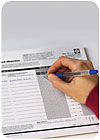
Is it the same thing every year? Your incident rates are up there above the national average and your MOD rates just won’t come down. You’ve got all your OSHA-required programs in order, everyone’s training is up to date, and you inspect and audit on a regular basis. Yet the injuries just keep on happening. Where else can you turn? Have you considered using your OSHA 300 Logs and first-aid reports to pinpoint problem areas and target “hot spot†jobs? After all, OSHA uses injury and illness data for focused inspections.
Although this isn’t the only method OSHA uses to target workplace inspections, the fact is that injury and illness records can be used to your benefit, too. You could say that there’s a gold mine of information buried there. And it all starts with keeping accurate records — recording only those injuries and illnesses that have to be documented.
Far too many employers record injuries that don’t need to be recorded — and this can distort incidence rates and make a company’s safety performance appear questionable. Not to mention that high incidence rates may result in OSHA inspections and lost contracts.
That’s why it is important to make knowledgeable recording decisions and document only those cases that meet OSHA’s criteria. Accurate recordkeeping can make a big difference in your incidence rates and the totals on your 300A annual summary.
Recording tips
The essence of good recordkeeping involves making recording decisions that reflect the true picture of an incident’s severity and not record those cases that OSHA considers minor. Because the rule has been around since January 2001, and in effect since January 2002, most employers have the general principles down pat. But, there are some recording tips that could make a difference as to whether a case is documented on the 300 or first-aid log and may ultimately play a role in reducing your incident rate. Knowing exactly what qualifies as a “first-aid†case is essential to the goal of lowering incident rates. Use the following tips to ensure your cases land on the proper log.Temporary/leased workers — The important thing to remember about temporary workers is that you have to record their injuries on your 300 Log only if you supervise their work on a daily basis. If the temporary agency employer supervises its employees on a day-to-day basis, their injuries have to be recorded on the temp agency’s log.
Restricted work and routine job functions — Recording restricted work means keeping an employee from performing one or more of the routine job functions, or working a regular full workday. “Routine job functions†are those job tasks done at least once a week. It’s important to have accurate, up-to-date job descriptions that clearly define the main functions of the job. Don’t record a case just because a physician prescribes work “restrictions.â€
When and where doesn’t matter — All treatments on OSHA’s first-aid list are not recordable — it doesn’t matter:
- whether they are performed by a physician, nurse, EMT or lay person;
- how many times they are administered; or
- whether the procedures are done in a hospital, clinic, emergency room or doctor’s office — the mere location of a procedure does not make an incident recordable.
Medications— OSHA considers non-prescription strength medications that can be bought over-the-counter (OTC) to be first-aid treatments and not recordable. However, when an OTC medicine is prescribed at prescription strength, the case becomes recordable.
This rule applies whether a doctor wrote the prescription or told the employee to buy the medication and take it at prescription strength. According to OSHA, both cases received equal treatment and are equally recordable. Recordability covers the giving or prescribing of all prescription-strength drugs — it doesn’t matter whether the employee actually takes the drug or even fills the prescription. The fact that medication was prescribed makes the case recordable. When a doctor gives an employee sample packets of prescription-strength medication or provides a prescription-strength antibiotic or antiseptic to prevent infection, the case becomes recordable.
Finger guards— Casts and splints that are designed to immobilize a body part are considered medical treatment; but rigid finger guards are always considered a first-aid treatment.
Bloodborne pathogens exposures— Record needlestick and sharps injuries only if they involve contamination with another person’s blood or body fluids. Initially classify these exposures as injuries.
- With a contaminated needle stick injury, if the employee is later diagnosed with an infectious bloodborne disease, reclassify the case as an illness.
- If an employee is splashed or sprayed with blood or other potentially infectious material (OPIM), record the incident as an illness only if it results in a diagnosed bloodborne disease.
Oxygen— Administering oxygen is a form of medical treatment; however, it may or may not be recordable.
- An incident is not recordable if oxygen is administered as a precautionary measure to an employee who doesn’t exhibit any symptoms of an injury or illness.
- But if the employee is exposed to a hazardous substance and shows exposure symptoms, then administering oxygen is considered medical treatment, making the case recordable.
Multiple body parts— When an incident results in injuries to multiple body parts, you may record them as a single entry on the 300 Log if the injuries:
- occurred from the same incident or exposure, and
- were diagnosed at the same time.
Take full advantage
Use all the injury, illness and incident tracking records to your full advantage. Analyze these documents for incident patterns and trends. Look for:- work areas with high rates and pinpoint hazardous job tasks;
- incident spikes at certain times of the day or week; and
- individual employee records — some people are prone to accidents that raise your rates.